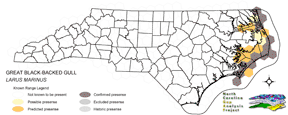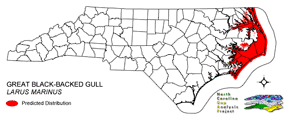
| Taxa: |
| Order: |
| Family: |
| Aves |
| Charadriiformes |
| Laridae |
| NatureServe Global Rank: |
| NatureServe State (NC) Rank: |
| G5 |
| S3B,S5N |
| Federal Status: |
| NC State Status: |
| --- |
| --- |


| Land Unit |
| US Fish & Wildlife Service |
| US Forest Service |
| US National Park Service |
| US Department of Defense |
| NC State Parks |
| NC University System |
| NC Wildlife Res. Com. |
| NC Forest Service |
| NC Div. of Coastal Mgmt. |
| Local Governments |
| Non-Governmental Org. |
| Other Public Lands |
| Private Lands |
| GAP Status 1-2 |
| All Protected Lands |
| Statewide |
| Hectares |
| 14,156.28 |
| 0.00 |
| 3,603.33 |
| 10,204.47 |
| 59.22 |
| 26.19 |
| 3,690.81 |
| 0.00 |
| 624.06 |
| 3.87 |
| 1,068.39 |
| 35.19 |
| 118,643.49 |
| 24,833.43 |
| 33,490.17 |
| 152,115.30 |
| Acres |
| 34,980.92 |
| 0.00 |
| 8,904.02 |
| 25,215.79 |
| 146.34 |
| 64.72 |
| 9,120.19 |
| 0.00 |
| 1,542.09 |
| 9.56 |
| 2,640.05 |
| 86.96 |
| 293,174.39 |
| 61,364.73 |
| 82,756.00 |
| 375,885.02 |
| % of Dist. on |
| Prot. Lands |
| 42.3 % |
| 0.0 % |
| 10.8 % |
| 30.5 % |
| 0.2 % |
| < 0.1 % |
| 11.0 % |
| 0.0 % |
| 1.9 % |
| 3.2 % |
| 3.2 % |
| 0.1 % |
| < 0.1 % |
| 74.2 % |
| ----- |
| ----- |
| % of Dist. on |
| All Lands |
| 9.3 % |
| 0.0 % |
| 2.4 % |
| 6.7 % |
| < 0.1 % |
| < 0.1 % |
| 2.4 % |
| 0.0 % |
| 0.4 % |
| < 0.1 % |
| 0.7 % |
| < 0.1 % |
| 78.0 % |
| 16.3 % |
| ----- |
| ----- |
|
NATURE SERVE GLOBAL HABITAT COMMENTS: ALL SEASONS: Primarily seacoasts, less commonly on large inland bodies of water (AOU 1983). BREEDING: Nests on ground or on rocks on rocky coasts and islands, occasionally on inland lakes. Along western North Atlantic coast, typically nests on small low islands, either rocky, grassy, or sandy with relatively little tall vegetation. On large islands, may nest on rocky peninsula, among boulders, or in low vegetation back from shore. Uses dredge-spoil islands. Usually nested under IVA FRUTESCENS in New Jersey salt marshes. Will nest with other gulls and cormorants (Spendelow and Patton 1988). |
| Code | Name | Description | NC Natural Heritage Program Equivalent |
| 378 | Ocean Beaches | Open beach sand. | Upper Beach |
| 3 | Tidal Marsh | Fresh and brackish tidal marshes, including cord grass, wild rice, sawgrass and needlerush alliances. | Brackish Marsh, Interdune pond, Maritime wet grassland |
| 124 | Maritime Scrubs and Tidal Shrublands | Coastal shrubs including wax-myrtle, swamp rose, alder, yaupon, and greenbriar. | Maritime Shrubs, Salt Shrub |
| 375 | Hypersaline coastal salt flats | Tidal flats within salt marshes, including saltmeadow cordgrass or sea-purslane dominated alliances. | Salt Marsh |
| 372 | Interdune Herbaceous Wetlands | Dune swales with permanently flooded to intermittently exposed hydrology. Species composition depends on salinity and can include cut grass, spike-rush, mosquito fern, and hornwort. | Interdune Pond, Maritime Wet Grasslands |
| 371 | Maritime Grasslands | Dune grass community consisting of sea oats and beach grasses. | Dune grass, Maritime dry grassland |
| 380 | Coastal Plain Fresh Water Emergent | Emergent vegetation in fresh water seepage bogs, ponds and riverbeds of the coastal plain. Includes alliances dominated by sedges, eelgrass, as well as cane found in unforested cane-brakes. | Small Depression Pond, Sandhill Seep, Floodplain Pool, Unforested Floodplain Canebrake, Riverscour Prairies, Vernal Pools |
| 180 | Agricultural Crop Fields | Farm fields used for row crops. | No equivalent |
| 205 | Agricultural Pasture/Hay and Natural Herbaceous | Farm fields used for pasture grass or hay production, as well as old fields dominated by native and exotic grasses. | No equivalent |
| 202 | Residential Urban | Includes vegetation interspersed in residential areas. Includes lawns, mixed species woodlots, and horticultural shrubs. Vegetation accounts for between 20 - 70% of the cover. | No equivalent |
| 203 | Urban Low-Intensity Developed | Highly developed areas with vegetation accounting for < 20% of the cover. | No equivalent |
| 8 | Open water | Open water without aquatic vegetation. | No equivalent |
|
Bent, A.C. 1921. Life histories of North American gulls and terns. U.S. Natl. Mux. Bull. 113. Washington, D.C.
Griffin, C. R., and E. M. Hoopes. 1992. Birds and the potential for bird strikes at John F. Kennedy International Airport. Final report, National Park Service, Boston, Massachusetts. 102 pp. Hyslop, C., and J. Kennedy, editors. 1992. Bird trends:a report on results of national ornithological surveys in Canada. Number 2, Autumn 1992. Migratory Birds Conservation Division, Canadian Wildlife Service, Ottawa, Ontario. 20 pp. Brown, R. G. B., and D. N. Nettleship. 1984. The seabirds of northeastern North America:their present status and conservation requirements. Pages 85-100 in Croxall et al., eds. Status and conservation of the world's seabirds. ICBP Tech. Pub. No. 2. Buckley, P. A., and F. G. Buckley. 1984. Seabirds of the north and middle Atlantic coast of the United States:their status and conservation. Pages 101-133 in Croxall et al., eds. Status and conservation of the world's seabirds. ICBP Tech. Pub. No. 2. Clapp, R. B., and P. A. Buckley. 1984. Status and conservation of seabirds in the southeastern United States. Pages 135-155 in Croxall et al., eds. Status and conservation of the world's seabirds. ICBP Tech. Pub. No. 2. Evans, P. G. H. 1984. Status and conservation of seabirds in northwest Europe (excluding Norways and the USSR). Pages 293-321 in Croxall et al., eds. Status and conservation of the world's seabirds. ICBP Tech. Pub. No. 2. Golovkin, A. N. 1984. Seabirds nesting in the USSR:the status and protection of populations. Pages 473-486 in Croxall et al., eds. Status and conservation of the world's seabirds. ICBP Tech. Pub. No. 2. Harrison, C. 1978. A field guide to the nests, eggs and nestlings of North American birds. Collins, Cleveland, Ohio. Terres, J.K. 1980. The Audubon Society encyclopedia of North American birds. Alfred A. Knopf, New York. American Ornithologists' Union (AOU), Committee on Classification and Nomenclature. 1983. Check-list of North American Birds. Sixth Edition. American Ornithologists' Union, Allen Press, Inc., Lawrence, Kansas. Spendelow, J.A., and S.R. Patton. 1988. National atlas of coastal waterbird colonies in the contiguous United States:1976-1982. U.S. Fish and Wildlife Service, Biological Report 88(5). x + 326 pp. Chapdelaine, G., and P. Brousseau. 1992. Distribution, abundance, and changes of seabird populations of the Gaspe Peninsula, Quebec, 1979-1989. Can. field-Nat. 106:427-434. Snell, R.R. 1991a. Interspecific allozyme differentiation among North Atlantic white-headed larid gulls. Auk 108:319-328. |
For more information please contact them at:
NC-GAP Analysis Project
Dept. of Zoology, NCSU
Campus Box 7617
Raleigh, NC 27695-7617
(919) 513-2853
www.basic.ncsu.edu/ncgap